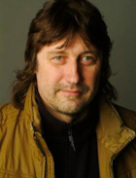
A New Day Dawns in the Eastern Corner| 1hr : 24mins
Director: Peeter Brambat | Producer: Peeter Brambat
Focus Years: 2008 | Country: Estonia
Synopsis:
Ordinarily, when we think of borders, it is in terms of the boundaries between states and peoples. In fact, borders also exist between differing cultures and religions. In many cases, religions and cultures cover broader swaths of territory than nations do. Occasionally, entire peoples can end up in the role of a buffer, acting as a 'human border.'
In this film, we take a look at the Setus, a European ethnic group who are wedged between two different cultures, the Orthodox east and the Catholic-Lutheran West. The border that this film examines is more than just a geopolitical feature separating states and peoples. We examine it as a line of demarcation situated between two attitudinally different worlds. Such a border isn’t completely visible to the naked eye. It is only discernible on the basis of personal experience, because this Setu border both separates and unites the peoples who live alongside the Setus.
In some respects, the Setus are richer for the experience. Thanks to frequent contact between the Setus and the Russians, the collective memory of the Setus incorporates a number of customs and beliefs from the past. This film shows how that memory has been transformed in modern times, since it has now blended with Russian Orthodoxy. The result is a unique subculture: a border culture.
The land of the Setus, sometimes also referred to as Setumaa or Setu Country, is located in the southeastern corner of the Republic of Estonia. Its boundaries are Lake Pskov in the north, Russia to the east, and Latvia in the south. Because of its location, Setumaa has seen more than its share of war during the past thousand years.
Two symbols of the past have survived until the present day. One is the Vastseliina Castle, which was built in 1274 on the Estonian side of the border by Friedrich von Hareldop, the Bishop of Tartu; the other is the Petchori Monastery, established in 1473 on the Russian side. For centuries, these two have been at the root of a love-hate relationship. As a result, this is an area that has known both piety and revelry. The Russians, Germans, Swedes, and Poles have all had their influence, showing and teaching the locals how to behave and leaving behind a legacy of their own customs.
The film examines the beliefs of the border people, in regards the material world as well as the hereafter. This is probably the only people of Europe who communicate with their ancestors by first attending a solemn liturgical service and then proceeding to the graves of the departed, where they unpack linen, food, and drink, seeking both physical and mental contact by visiting with their departed relatives. It is difficult to draw a line between what has been and what is. The procession is concluded with a 'kirmask,' merrymaking where white lightning is consumed, and people dance until dawn.
This is also where two sets of religious beliefs and teachings abut. A “castrum fortissumum in tota patria,†the mightiest fortification on the eastern border of Catholicism, also represented Western thought and Western presence. The Petchori Cloister stood for the Orthodox way of obedience to God.
In the 19th Century, Setumaa was subordinated to the Pskov District, but later the Tartu Peace Treaty of February 2, 1920 ceded Setumaa to Estonia. Statistics show that in 1934, the Setus, who use Estonian as their lingua franca, made up 55% of the local population. Russians constituted 41% of the local population, while other nationalities contributed 4% to the mix.
Having driven out the Nazis and occupied Estonia in 1944, the Russians annexed much of Setumaa, making it a part of the Pskov Oblast of the USSR. Once again, many Setus ended up in the Russian sphere of cultural influence. Because the Estonian SSR was made part of the same Soviet state, with no internal borders, as Pskov Oblast, the Setus weren't restricted to one territory or another and were able to conveniently travel throughout the Setu area, parts of which lay on either side of the border between the Russian Soviet Socialist Republic and the Estonian Soviet Socialist Republic. It was easy for them to go see relatives and to tend to the graves of the deceased.
The situation changed cardinally on November 5, 1996, when Estonian foreign minister Siim Kallas and Russian foreign minister Yevgeni Primakov met in Petchori and agreed on a control line between Russia and Estonia, which left about a thousand Setus on Russian territory. Estonia was in a hurry to find a place for itself beneath the protective umbrella of the European Union. For the Setus, the result was a split personality, with some of their roots left on either side of the dividing line, including cemetery plots, real estate, tracts of forest, etc.
The central figure of the film is a man who lives right atop the border. His house literally straddles the control line, with half of the structure in Russia and half in the Estonian Republic. The pine forest his grandfather planted is hopelessly stuck on the far side of the border. Having been cut off from Estonian territory for a long time, this area has adopted a lot of Russian influence but has resisted assimilation. The Setus have succeeded in maintaining their own dialect of the Estonian language, as well as a distinct culture and set of beliefs and customs.
The Setus live in a traditional natural environment. Despite conversion to the Orthodox confession, they retain a number of pagan traditions from the past. Peko, a totem fertility cult figure, still has a place in the saunas of Setu farmsteads. It is worth noting that the Orthodox Church has exhibited tolerance towards the distinctive beliefs of the Setus, along with their celebrations. It would be fair to say that what the Church has set out to do is to play a balancing role.
This is the story of a people who make do, living on the eastern border of the European Union between two powers and two ways of seeing the world. One way or another, they are involved in the dawning of a new day for themselves and Europe.
A New Day Dawns in the Eastern Corner
|
1hr : 24mins
Search information, ideas, subjects related to this story:
Wikipedia :
- Seto dialect
- Setos
- Alternative Communities
- Collective
- Communitarianism
- Communities
- Community Psychology
- Community-supported agriculture
- Cultural Assimilation
- Cultural Relativism
- Eco-communalism
- Human Geography
- Indigenous Intellectual Rights
- Indigenous People
- Indigenous Rights
- Interculturalism
- Interculture Relations
- Interculture_Relations
- Land Rights
- Local Purchasing
- Psychology
- Racial Integration
- Toleration
- Traditional Knowledge
Other Articles/Sites :
Send funds to team of this film/project:
NOTE: 100% of your funds are sent directly from here.

Close
This storyteller has yet to share/set a wallet for the direct fund transfers.
Shall we send an email request on your behalf?
Close
peace



